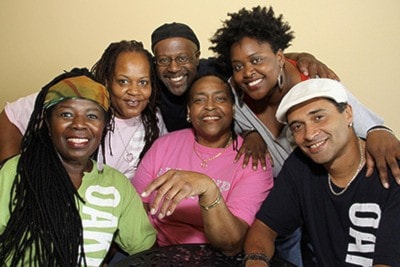Two decades, ago Linda Tillery heard a choir singing spirituals on a television program and thought, “Wow, I really like that!”
She began an in-depth exploration of African American music that resulted in a youth choir and eventually the Grammy-nominated Cultural Heritage Choir.
Tillery and the Cultural Heritage Choir bring their high-energy blend of percussion-driven a capella sounds to the Sid Williams Theatre on Nov. 15 at 7:30 p.m.
The vocal ensemble’s mission is to preserve and share the rich musical traditions of African American roots music with its strong ties to West Africa and the Caribbean.
“Researching African American music was one of the most gleeful things I’ve ever done,” says Tillery. “I went to the Smithsonian in Washington, D.C., corresponded with scholars, bought field recordings from the Library of Congress, watched old film footage and was fortunate enough to have two really great professors of music as mentors.”
Tillery found the field recordings especially helpful and spent months listening to them.
“I was totally engrossed in the subject,” she admits. “And after about five or six years I finally felt comfortable with the fact that I might know a little bit about African American roots music.”
Like most roots/folk music, the survival of African American music depended on being passed on through oral traditions.
“It’s amazing, all through the United States music was being shared in this way,” says Tillery. “People learned and remembered the words to songs from one state to another.”
Tillery experienced one aspect of this herself as a child attending church services in the California Bay Area. “I remember hearing long-metered hymns — they basically stretch words out over a long period of time,” she explains. “I always say you could wash the dishes, do the laundry and mop the floor before the first word is finished being sung. And everyone knew how to stretch out the words in the same way.
“What’s fascinating is that many African American songs were originally Welsh, Irish or British hymns reconstituted by enslaved Africans.”
Tillery’s studies also exposed her to Shape Note singing where tonal sounds such as do, ra, me, fa, so are used instead of words.
“My research opened up more than one world to me,” she says. “It was overwhelming and exciting to discover all these songs and song forms.”
Tillery formed the Cultural Heritage Choir in 1992, noting that the group grows as their repertoire does.
“Our first really important period came when one of the co-producers of the Vancouver Folk Festival heard about us and invited us to perform,” she says. “We’ve had an ongoing relationship with Canadian festivals for nearly 14 years now.
“For a long time our biggest fan base was in Western Canada,” she continues. “People there really understand what we’re all about. Some of our most memorable moments have been in B.C. and Alberta. We love performing in Canada.”
On this tour, the Cultural Heritage Choir will visit the Comox Valley, Quadra and Salt Spring islands for the first time. If their sound equals even a tiny fraction of the warmth, friendliness and enthusiasm Tillery’s voice had over the telephone, audiences are in for a very special concert.
Tickets for the Comox Valley performance are available at the Sid Williams Theatre. For more information, visit www.sidwilliamstheatre.com or phone 250-338-2430.
Paula Wild is a published author and regular contributor to the Comox Valley Record's arts and entertainment section. www.paulawild.ca
